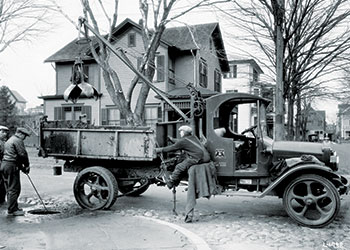A History of Mack Trucks

For more than a century, Mack Trucks has been known as one of America’s top manufactures of heavy-duty vehicles. The phrase “Built like a Mack Truck” is part of the American lexicon, while their bulldog symbol is instantly recognizable to millions of people around the globe. Thanks to blockbuster films like Michael Bay’s Transformers: Dark of the Moon, in which lead character Megatron transforms into a military grade Mack truck, and Disney’s animated Cars series, which features a semi-trailer truck named “Mack”, they have even transcended into the world of pop culture.
But for those of us living in the Lehigh Valley, Mack Trucks is more than just an iconic worldwide brand. With its main assembly plant located in Lower Macungie Township, it is part of our local heritage, and has directly impacted the lives of generations of our residents.
The Birth of Mack Trucks
What would eventually become one of the greatest truck manufacturing companies in the United States, Mack Trucks got its start in 1890, when 26-year-old John “Jack” Mack took a job at a carriage building company in Brooklyn, New York, called Fallesen & Berry. Joined by his younger brother, Gus, the Mack brothers purchased the company three years later. Within a year, they were joined by a third brother, William, who had previously been operating a wagon building company in Scranton.
With the three Mack brothers now at the helm, they began to shift their focus from carriage building to wagon construction, while also experimenting with new steam and electric powered motors. In 1900, the brothers got their first big break when a tourism company out of Prospect Park in Brooklyn contracted them to build a sightseeing bus. This bus, which carried 15 to 20 passengers and was powered by an engine designed entirely by the brothers, became the first vehicle to bear the “Mack” nameplate.
Pleased with its product, the tourism company ordered a second bus in 1901. With their company now firmed established as an automotive manufacturer, the brothers incorporated in 1902 – and the Mack Brothers Company was officially born.
 Move to the Lehigh Valley
Move to the Lehigh Valley
As the Mack Brothers Company steadily grew, the need for additional manufacturing and assembly space became apparent. To meet their expanding needs, the brothers decided in 1905 to open a second production facility in an old foundry on the south side of Allentown, Pennsylvania. A fourth brother, named Joseph, was already living in the area and joined them as a stockholder.
The year Mack Brothers moved to Allentown, the company built 51 vehicles – a tremendous jump in production. While the majority of their products were buses, the company also built two types of delivery style trucks.
Although the corporate headquarters remained in New York, the Mack brothers closed their Brooklyn plant in 1907, and consolidated all production at the Allentown facility. Over the next several years, the company continued to expand into a variety of heavy vehicles. Their motto, adopted in 1907, reflected what Mack trucks were best known for: “Simplicity, Strength, Durability, and Plenty of Reserve Power”.
Rise to National Prominence
By 1911, the Allentown factory had grown to employ approximately 700 people. That same year, the company also began a series of mergers that would ultimately help transform it into one of the best-known truck manufacturers in the United States.
The first of these changes occurred in 1911, when the Mack Brothers Company merged with the Sauer Motor Company to form the International Motor Company, known as IMC. A year later, IMC was joined by the Hewitt Motor Company, which brought with it engineers Edward R. Hewitt and Alfred Masury.
At the outbreak of World War I, the British government purchased 150 Mack ACs to transport troops, food, and supplies in France. Their performance on the battlefield was so impressive that the British gave them the nickname “Bulldog Macks”. When America entered the war the following year, the U.S. military adopted the Mack AC as the army’s standard 5-ton truck. In total, just under 4,500 Mack ACs were used in the war effort.
In the years following the war, the Bulldog nickname stuck with the company, and in 1922 Mack adopted it as its official corporate symbol. Ten years later, Alfred Masury crafted the first Bulldog hood ornament – creating what would become one of the automotive industry’s most recognizable corporate emblems.
Although somewhat stymied by the Great Depression, Mack continued to expand its line throughout the 1930s. Perhaps its most significant achievement was the introduction of its own diesel engine in the summer of 1938. As the first independent truck manufacturer to produce such an engine, this was a significant contribution in helping the heavy-truck industry shift towards the efficiency of diesel power.
As with most all industry in the United States, the outbreak of World War II prompted Mack to shift into wartime production mode. Civilian truck manufacturing was temporarily suspended so the company could focus on meeting the needs of the fighting man – which it did by producing 26,000 six-wheel trucks, 4,500 five-ton four-wheel trucks, and 4,600 powertrains for M3 Stewart and M4 Sherman tanks. Part of the Allentown plant was even temporarily taken over by the government and used for the production of Vultee aircraft.
While Mack trucks supported troops stationed around the world, they also played a pivotal role at home by helping transport wartime goods and supplies. In one of their most impressive moves, two Mack trucks hauled the body of a DC-3 transport aircraft from Houston to Dallas in May 1943. Driving a distance of 340 miles, it was reported to be the largest and widest load transported over state highways at the time.
The 1950s marked a period of significant growth, fueled in part by the establishment of the United States’ interstate highway system. Signed into effect by Congress as the Federal Aid Highway Act of 1956, the act authorized the construction of a 41,000-mile network of interstate highways that would connect all 48 contiguous states. In part because of this initiative, gross sales of Mack trucks soared to a quarter of a billion dollars in 1956, with a net profit of more than $12 million. In 1959, net profits again reached a new high of $15.8 million.
In 1965, after decades of continued growth, Mack announced that its corporate headquarters would move to Allentown in order to be closer to the main assembly plant. Construction of a new Mack World Headquarters building began, and on April 28, 1970, it officially opened. Five years later, a new Engineering Development and Test Center also opened in Allentown. This 65-acre facility was capable of taking new vehicles and components through all phases of design and analysis, and included a test track as well as a state-of-the-art chamber for measuring engine and mechanical noise. A year later, another assembly plant also opened in nearby Macungie.
In addition to vast growth, the 1970s also brought about one of the most important changes in Mack’s corporate structure. In 1979 the company entered into an agreement with French manufacturer Renault. This allowed Renault to purchase a 10% equity interest in Mack, while also making Mack the North American distributor of its medium-duty diesel trucks. Later, this agreement would prove crucial in helping Mack to weather some of its most challenging years.
An Era of Turbulence and Change
The 1980s opened as one of the most turbulent decades in the company’s history. For the first three years, Mack posted consecutive losses in the tens of millions. Although the company briefly returned to profitability in 1984, the losses were indicative of a general downturn that would continue to affect the industry for years to come.
In January 1986, after posting a net loss of nearly $65 million for the third quarter of the previous year, Mack announced that it would close its Allentown plant. Four years later, in 1990, Mack became a wholly-owned subsidiary of Renault. As Mack was still facing serious financial challenges at the time, this led to an aggressive restructuring campaign that involved closing several more manufacturing and assembly locations. These changes eventually helped the company returned to profitability in 1994. By the end of 1998, Mack recorded six straight years of market growth – becoming the only U.S. heavy-duty truck manufacturer to do so at the time.
Mack Trucks in the 21st Century
The dawn of the 21st Century brought yet another major change in Mack’s corporate structure. In 2000, as Mack celebrated its 100th anniversary, Swedish manufacturer AB Volvo acquired the company – a move that led to many major changes in the Lehigh Valley.
In 2009, Mack’s corporate headquarters, along with all the operations that had been performed in the Engineering Development and Test Center facility, moved to Volvo’s campus in Greensboro, North Carolina. Mack production was also consolidated in the Macungie plant – marking the first time in 80 years that all Mack vehicles were built in one location. The following year, the old development and test center building was transformed into the Mack Customer Center. This facility now boasts a large corporate showroom, the expansive Mack Museum, and regional offices.
Today, every Mack truck built for the North American market is assembled at the plant in Lower Macungie Township. The company is also the township’s largest employer, providing just fewer than 1,900 jobs. Although it was recently announced the facility may begin a series of cutbacks due to a projected slowdown in demand in 2016, it seems safe to say that, as they have for more than 115 years, Mack trucks will continue to endure well into the future.














